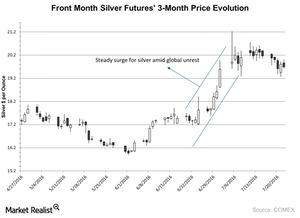How Investor Appetite for Risk Impacts Precious Metals
Gold and silver have seen trailing-five-day losses of 0.9% and 2.7%, respectively. The reason behind the fall in the precious metals is the buoyancy of the equity markets and the gains in the US dollar.
Dec. 4 2020, Updated 10:53 a.m. ET

Demand slows down
Gold has seen a downward swing and has extended its first back-to-back weekly drop since May. Gold and silver have seen trailing-five-day losses of 0.9% and 2.7%, respectively. The reason behind the fall in the precious metals is the buoyancy of the equity markets and the gains in the US dollar. Both factors have significantly hurt the precious metals.
The holdings of the SPDR Gold Shares (GLD), the world’s largest gold-backed ETF, fell 0.22% to 963.1 tons on Thursday, July 21. The physical demand from the giant gold-consuming markets, India and China, has also been slowing down.
Is risk appetite rising?
Investors’ risk appetite got a boost from the strong corporate results announced by major international companies in Europe and the United States over the past week. The rise in the risk-taking ability of investors hurts the appeal of safe-haven assets such as gold and silver.
Funds and miners rose
Both gold and silver rose substantially after the Brexit vote due to the rising global risk sentiment. Even the mining companies have risen. Harmony Gold Mining (HMY), Alacer Gold (ASR), and Compañia de Minas Buenaventura (BVN) have risen 19.3%, 4.2%, and 12.3%, respectively, on a trailing-30-day basis. Combined, these three stocks make up 5% of the VanEck Vectors Gold Miners ETF (GDX).
The Direxion Daily Junior Gold Miners Index Bull 3x Shares (JNUG) and the ProShares Ultra Silver ETF (AGQ) have risen 22.1% and 20.1%, respectively, on a trailing-30-day basis.
